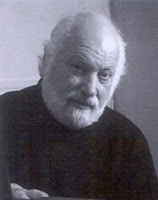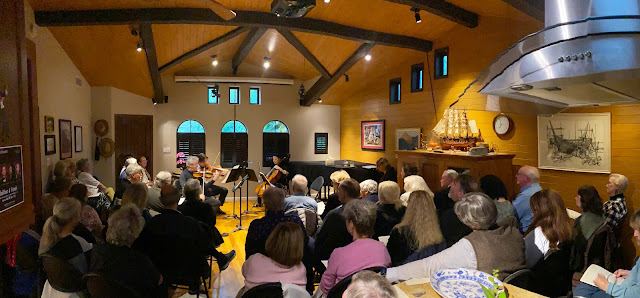 |
| The Pacific Symphony Orchestra and Pacific Chorale under Carl St. Clair perform the world premiere of Sir James MacMillan's Fiat Lux. |
REVIEW
“Cathedrals of Sound,” Pacific Symphony Orchestra, Segerstrom Center for the Arts, Costa Mesa
DAVID J BROWN
One long-term artistic casualty of the Covid pandemic has been the long-delayed unveiling of Fiat Lux, the latest in a substantial sequence of religious-themed choral/orchestral works by the Scottish composer, Sir James MacMillan (b. 1959). Originally commissioned some five years ago by the Pacific Symphony through a generous grant from Howard and Roberta Ahmanson (right) and rapidly completed in 2020, the piece finally reached the platform of the Renée and Henry Segerstrom Concert Hall on Thursday, June 15, two years later than originally planned.
 |
Though for this the Chorale’s full strength of over 100 singers was reduced to just 28—the brilliantly lit group centered within the expanse of the Segerstrom’s performing area, surrounded by tints and shadows in various dark reds (below)—the expressive power of this setting of Psalm 51 was immediate and penetrating, with the alternation between verses sung by the main chorus and then by the small, distant second group of just four voices, invisible beyond stage left, adding a haunting and widely-spaced lateral dimension.
 |
| Gregorio Allegri. |
With the lighting effects returned to bright normality, the full forces of the Pacific Symphony entered for the first time, to play Richard Strauss’s early tone-poem Tod und Verklärung (Death and Transfiguration) Op. 24, TrV158 (1888-89). Again introduced by Carl St. Clair, emphasizing the work’s appropriateness within the context of the evening, his interpretation was trenchant but broad, clocking in at some 25 minutes when most performances seem to time out at around the 22-23 minute mark.
 |
| Richard Strauss in 1888. |
But what watching and hearing this great orchestra did demonstrate was how restrained Strauss’s timbral palate is in this of all his tone-poems: a rolling surge of blended orchestral richness but with no pealing bells, organ underpinning or clashing cymbals to crown the final climax, nor indeed the use of percussion, apart from timpani, anywhere in the piece except for the tam-tam strokes that mark the anonymous protagonist’s moment of death—the Pacific Symphony’s magnificent instrument positively bowel-shaking in this performance.
As the Strauss scholar Charles Youmans notes, “Strauss settled into a comfortable atheism while still in his teens,” and it thus seems permissible to acknowledge and welcome the way in which the inclusion of Tod und Verklärung between the specifically Christian responses by Allegri and MacMillan to those themes of spirituality and transcendence showed them to be just as viable and meaningful in a secular as in a religious context.
 |
| Carl St. Clair and the Pacific Symphony Orchestra at the climax of Richard Strauss's Tod und Verklärung. |
And so, after the interval, to Sir James MacMillan’s Fiat Lux. In a brief conversation with the composer at the reception after its triumphant premiere (no hyperbole there), he agreed that his conceptual response to the challenge of setting the words of the Californian poet Dana Gioia had been influenced both by the acoustic quality of this hall, with its magnificent four-manual William Gillespie Concert Organ, and by the participation of these particular performers.
In sheer aural splendor and teeming variety of pace, texture, and sonority, the result certainly vindicated the concept and commitment of all concerned. Fiat Lux is scored for soprano and baritone soloists, mixed chorus, large orchestra including much percussion, and organ. Playing for little over half an hour, its single span is divided into five linked sections, the first setting the opening lines of Genesis and the other four sections the verses by Mr. Gioia.
 |
| l-r: Dana Gioia, Sir James MacMillan, and Carl St. Clair at the reception after the performance. |
 |
| Elissa Johnston. |
Indeed here, and elsewhere in the work, the juxtaposition of sharply different musics in terms variously of meter, pace, harmony and texture—sequential, overlapping, or simultaneous, as if to see what emanates or explodes out of the clash—was a prominent feature, and which seems, on my admittedly limited knowledge of his other works, to be a notable characteristic of his soundworld.
 |
| Christopher Maltman. |
Section IV “Closing Verses,” sung by the two soloists to delicate, flickering orchestral accompaniment, is effectively preludial to the final “Hymn: Cathedral of Light,” the six stanzas of which are sung alternately by choir and soloists. The chorale setting for the former felt somewhat effortful and combative—appropriate perhaps when you are singing of “Our cross and spire built in a land of quake and fire”—contrasting with the soloists’ airborne and, indeed, light-filled music. The full forces came together in a final Amen which however, far from settling on any resolution either prayerful or joyous, instead swelled in a massively defiant and dissonant crescendo that reminded me, if anything, of the pulverizing final pages of Havergal Brian’s Fourth Symphony, “Das Siegeslied.”
Overall though, a more apt comparison amongst British choral works in terms of duration, forces involved, and expressive tenor would be with Vaughan Williams’ Dona Nobis Pacem (memorably performed here last year by the Pacific Chorale and Pacific Symphony) and perhaps even more so VW’s short oratorio Sancta Civitas. With the latter’s text drawn from the Book of Revelation, and the two works thus dealing respectively with Biblical first and last things, Fiat Lux and Sancta Civitas would seem a most appropriate concert pairing.
 |
| l-r: Sir James MacMillan, Dana Gioia, Elissa Johnston, Carl St. Clair, Robert Istad, and Christopher Maltman welcome the Segerstrom ovation. |
Meanwhile, clearly unfazed by MacMillan’s uncompromisingly modern idiom and the absence of accessible melodic “hooks,” the Segerstrom Concert Hall audience greeted the performance with vociferous enthusiasm, cheering the conductor, choral director, soloists, poet, and in particular the composer back to the platform again and again. Fiat Lux was heard twice more on succeeding nights, followed by a special encore performance on June 20 at Christ Cathedral, Garden Grove, the 2019 consecration of which was another inspiration behind the work.
---ooo---
Pacific Symphony Orchestra, Renée and Henry Segerstrom Concert Hall, Thursday June 15, 2003, 8 p.m.
Images: The performance and reception: Doug Gifford; Allegri, Richard Strauss: Wikimedia Commons; Christopher Maltman: Chris Singer, courtesy artist website; Elissa Johnston: Los Angeles Master Chorale.
If you found this review enjoyable, interesting, or informative, please feel free to Buy Me A Coffee!










.jpg)

.jpg)









